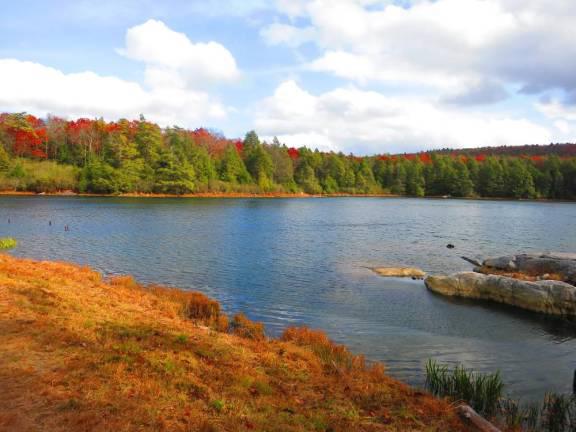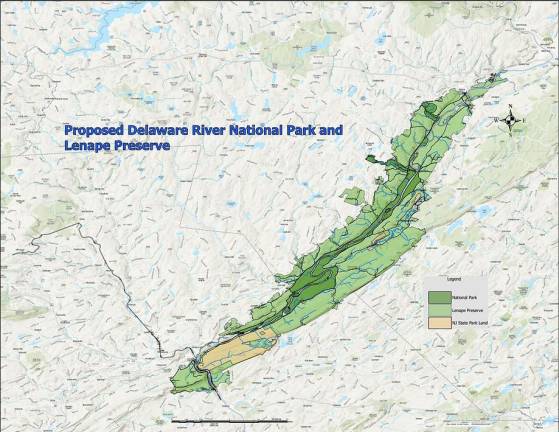Momentum builds for ‘No National Park’ movement
Delaware Water Gap. The opposition made comparisons to Tocks Island dam project in a recent public forum against the move.


Activists opposed to the re-designation of the Delaware Water Gap National Recreation Area as a national park held a meeting Saturday, March 9 at the Sandyston Township Municipal Building in Hainesville.
A packed crowd and those attending via Zoom heard reasons why the change might not be such a good idea. Speakers discussed traffic impacts, visitation numbers, and environmental and agricultural impacts. Several public officials signaled their support of the movement, which has close to 5,000 followers on Facebook and over 7,500 signers of a petition on change.org.
NJ Assemblyman Mike Inganamort (R-24) said he, Assemblywoman Dawn Fantasia (R-24), and State Senator Parker Space (R-24) will submit an amended bill (AR 157) to the state opposing the national park. A representative of Republican Congressman Thomas Kean Jr.’s office Zoomed the meeting and reconfirmed the congressman’s support for the “No National Park” movement.
The group heading the efforts to defeat the national park proposal is the Delaware Water Gap Defense Fund. The face of this group is activist Sandy Hull, a New Jersey native of the Delaware Water Gap area. The far less visible group pushing for the national park initiative is Delaware River National Park and Lenape Preserve Alliance, mainly accessible via their website at ourpark.org.
Senator Space explained in a 2022 press release the origins of this push: “In 2016, the National Park Service proposed a plan titled ‘Vision 2030: A Vision for a Sustainable Future’ (‘Vision 2030’), which proposed to change the designation of the Delaware Water Gap from a National Recreation Area to a National Park and Preserve, and to expand the area of the present Delaware Water Gap.”
He added that in 2022 a similar project, titled “Delaware Water Gap: Redesignation Project,” was introduced proposing the same move.
Space said at the time, “This designation change to a National Park and Preserve is not necessary and would upset the recreation area’s original mission and put uses such as hunting and farming at risk. A new designation that translates into prohibitions and restrictions on currently allowable activities in the recreation area would have a negative impact on our region.”
Sandy Hull claims that traffic could increase from 4 million to 4.6 million visitors annually. She expressed concern about local resources being stretched, such as EMS services. She also said she was concerned that the government would exercise eminent domain to expand the national park areas, something the Delaware River National Park and Lenape Preserve Alliance deny.
The National Recreation Area is underfunded, Hull said, noting that there is no guarantee that a national park would get a windfall of federal money. “The National Park Service is severely underfunded and facing budget cuts,” she added.
While the public momentum is tilting away from a national park, Hull is concerned that the re-designation can be tacked on to an omnibus bill by a congressperson in a far-off district. That’s how the Tocks Island dam project got started, she said. Of course, Tocks Island dam, which would have built a dam on the Delaware River and flooded a large swath of the valley, never gained final approval. It only took 40 years for the project to be officially scrapped.
Those for and against
Both sides of the matter have a number of organizations supporting their efforts, but the No National Park side also has public servants and municipalities signaling their support.
The No National Park website (nonationalpark.org) listed the following counties and municipalities that have passed resolutions to oppose the re-designation “until more information is provided to the public for review and comment.”
In New Jersey these include Sussex County, Warren County, Sussex Borough, Montague Township, Sandyston Township, Hampton Township, Stillwater Township, Frankford Township, Fredon Township, Franklin Borough, Sparta Township, Greene Township, Andover Borough, Lafayette Township, Byram Township, and Frelinghuysen Township. In Pennsylvania, the opposing municipalities include Shohola Township, Dingman Township, Milford Township, Delaware Township, Lehman Township, Westfall Township, and Porter Township.
Members of Congress and local politicians who are opposed include NJ Congressman Josh Gottheimer (D-5), NJ Congressman Thomas Kean (R-7), Pennsylvania Congressman Matt Cartwright (D-8), former NJ State Senator Steve Oroho (R), NJ State Senator Doug Steinhardt (R-23), Senator Space, former NJ Assemblyman Hal Wirths (R), PA State Senator Lisa Baker (R-20), former PA State Representative Joe Adams (R-139), and PA State Representative Maureen Madden (D-115).
Educational bodies who have passed resolutions opposing the re-designation include Kittatinny Regional High School, the Hampton Board of Education, Montague Township Board of Education, and Sandyston Township.
Organizations who are opposed include the Delaware River Keeper Network, the Pike County Planning Commission, the Pennsylvania Farm Bureau, the Hercules Rod & Gun Club, the NJ Federation of Sportsmen, the PA Federation of Sportsmen, New Jersey Outdoor Alliance, Orange County Federation of Sportsmen, the Bergen County Federation of Sportsmen, Lehigh Valley Chapter of the Safari Club, and the Delaware River Shad Fishermen’s Association.
The Pike County Commissioners and Monroe County Commissioners have written letters to Congress requesting that the project not proceed until more information is made available.
The pro-national park side has the support of the Nanticoke Lenni-Lenape Tribal Nation of southern New Jersey and northern Delaware, Be Outdoors Appalachian Mountain Club, Penn Environment, Environment New Jersey, Green Valleys Watershed Association, Pocono Heritage Land Trust, New Jersey Highland Coalition, Atlantic Chapter of the Sierra Club, and the Sierra Club of Pennsylvania.
As reported last September, the local indigenous people, the Ramapough Lenape Nation, oppose the national park initiative.